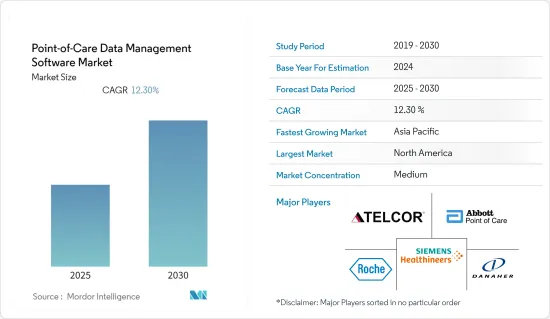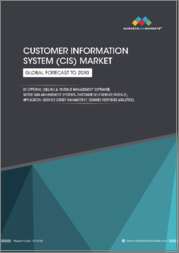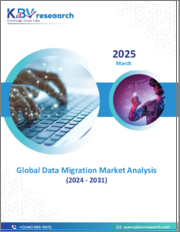
|
시장보고서
상품코드
1630453
POC(Point-of-Care) 데이터 관리 소프트웨어 : 시장 점유율 분석, 산업 동향 및 통계, 성장 예측(2025-2030년)Point-of-Care Data Management Software - Market Share Analysis, Industry Trends & Statistics, Growth Forecasts (2025 - 2030) |
||||||
POPC(Point of Care) 데이터 관리 소프트웨어 시장은 예측 기간 동안 12.3%의 CAGR을 기록할 것으로 예상됩니다.

주요 하이라이트
- 의료의 가치관 변화와 기술 발전으로 인해 현장진단(POCT)에 대한 수요가 증가하고 있으며, POCT에 대한 수요를 촉진하는 몇 가지 요인이 있습니다. 감염성 질환의 증가, 심장병 및 당뇨병과 같은 생활습관병의 증가, 재택 POC 기기 사용을 원하는 환자의 증가, 더 빠르고 사용하기 쉬운 기기를 만들어내는 기술 발전 등이 있습니다.
- 전 세계적으로 약 5억 1,100만 명의 성인이 당뇨병을 앓고 있으며, 2040년까지 이 숫자는 5억 7,000만 명 이상으로 늘어날 것으로 예상됩니다. 전 세계적으로 당뇨병이 계속 증가하고 있는 가운데, 당뇨병에 대한 인식 개선 노력도 필요합니다. 당뇨병을 앓고 있는 성인의 37%가 아시아태평양에 거주할 것으로 예상됩니다. 국제당뇨병연맹(International Diabetes Federation)에 따르면 2021년 전 세계 당뇨병 환자 수는 5억 3,700만 명에 달할 것으로 예상되며, 2021-2045년 사이 당뇨병 치료에 대한 전 세계 지출은 9억 6,600만 달러에서 10억 5,300만 달러로 증가할 것으로 예측됩니다. 미국 질병예방통제센터(CDC)의 최근 보고서에 따르면, COVID-19 진단을 받은 당뇨병 환자의 50% 이상이 입원해 있습니다.
- 현장진단검사(POCT)를 통한 임상 증상의 신속한 진단은 환자의 결과를 개선할 수 있으며, POCT의 성장 배경에 있는 주요 개념은 검사를 환자에게 더 가깝게 가져와 의료진에게 결과를 빠르고 간편하게 제공하여 진단과 치료를 가속화할 수 있다는 것입니다. 오늘날의 POCT 기기는 변화하고 있지만, 컴플라이언스를 문서화하는 데 필요한 데이터를 수집하는 데는 여전히 시간이 걸립니다. 강력한 POCT 관리 시스템과 연결 솔루션은 수작업으로 결과를 입력하는 시간을 단축하고, 수작업으로 인한 오류를 없애고, 결과에 대한 실시간 액세스를 용이하게 하여 의료진이 적시에 의사결정을 내릴 수 있도록 돕습니다.
- 또한, 의료 데이터 분석이 환자 중심 진료와 집단건강관리를 지원하기 위해 의료 데이터 분석이 더욱 보편화됨에 따라 POCT 결과를 전자적으로 통합하고 결과 추적 지표와 핵심 성과 지표를 포함시키는 것이 필수적입니다. 미국의 전자건강기록(EHR) 지출은 2015년부터 2019년까지 연평균 5.4% 성장하여 2019년에는 총 145억 달러에 달할 것으로 예상됩니다. 일본 간호협회 조사에 따르면 2019년 9월부터 10월까지 일본 병원의 약 63%가 EMR 시스템을 도입했습니다. 일본 정부는 2,000년대 초부터 시스템 사용을 장려해왔습니다.
- COVID-19 사태로 인해 전 세계 의료 시스템은 생명을 구해야 하는 수많은 환자를 처리하기 위해 큰 부담을 안게 되었습니다. 일부 국가에서는 수술용 마스크, 안면 보호대, 인공호흡기, 환자를 위한 물리적 공간과 침대와 같은 중요한 의료 장비가 부족하거나 부족을 겪고 있거나 준비 중입니다. 첨단 의료 장비의 세계에서는 이러한 기본적인 필수품이 우선순위를 차지합니다.
POC(Point-of-Care) 데이터 관리 소프트웨어 시장 동향
병원/중환자실 부문이 큰 시장 점유율을 차지할 것으로 예상
- 병원에서 현장 검사(POCT) 및 전자 의료 기록 시스템의 사용이 증가함에 따라 실시간 전자 결과 보고의 중요성이 커지고 있으며, POCT 데이터 관리 시스템은 이러한 모델을 지원하는 시장의 변화하는 요구에 맞춰 진화하고 있습니다. 웹 기반 연결성 데이터 관리 플랫폼은 캠퍼스에서 캠퍼스까지, 또는 주에서 주까지, 병원 전체에서 웹 기반 연결성 데이터 관리 플랫폼을 통해 현장 검사 프로그램 관리의 주요 효율성을 실현할 수 있습니다.
- POC(Point of Care) 기술의 가장 중요한 측면은 침대 옆에서의 존재감이며, POC 기술은 환자와 간호사, 의사, 의사 및 외과 의사와의 상호 작용을 촉진하고 개선하여 의료 결과를 개선 할 수 있습니다. 침대 옆 포도당 검사는 POC 시장에서 가장 널리 보급되어 있고 가장 큰 규모를 차지하고 있습니다. 이들은 가장 먼저 개발 된 장비이며 수백 개의 장비와 수천 명의 운영자가 관련되어 있습니다.
- 또한, 각 병실/치료 공간에 벽걸이형 POC 단말기를 설치하거나 바퀴가 달린 워크스테이션을 설치하면 모든 병원에서 상당한 시간 단축과 비용 절감을 실현할 수 있습니다. 여러 연구에 따르면, 간호사들은 근무 시간의 25-50%를 연필과 종이를 사용하여 물리적인 의료 기록을 작성하는 전통적인 문서 작성에 소비하는 것으로 나타났습니다. 이는 간호사가 중요한 환자 데이터를 정확하게 찾고, 작성하고, 수정하고, 중요한 환자 데이터를 저장하는 데 정기적으로 관여하고 있음을 의미합니다.
- 또한 중환자실(ICU)/중환자실 임상의는 제한된 공간에서 중증 환자를 치료하는 경우가 많으며, 이때 신속한 의사결정을 내려야 하는 경우가 많습니다. 따라서 중환자실에서는 POCT를 환자 관리의 일상적인 요소로 활용하고 있으며, 특히 혈액가스 분석에 POCT를 사용하는 경우가 증가하고 있습니다. 혈액가스 분석기(BGA)의 주요 목적은 혈액가스 수준(pH, pHO2, pHCO2 등)의 정확한 측정 값을 제공하는 것이지만, 최신 분석기는 현재 헤모글로빈 및 전해질 농도(나트륨, 칼륨, 염화물, 이온화 칼슘 포함)와 같은 추가 매개 변수를 동일한 혈액 샘플에서 측정 할 수 있습니다. 파라미터를 측정할 수 있습니다.
- NTT 데이터(NTT DATAzGroup)와의 제휴를 통해 스페인 병원의 SmartICU 개발은 더 나은 임상 결과를 얻기 위해 의사와 기술자를 NTT DATA의 데이터 과학자와 팀을 구성하여 더 나은 임상 결과를 얻었습니다. 병원과 함께 SmartICU 솔루션을 개발하기 위한 1년간의 여정이 시작되었을 때, 팀은 데이터 관리 및 보고가 주요 장애물임을 인식했습니다.
- 중요한 병동 데이터 소스는 간호사가 수작업으로 시간당 측정하는 것과 같이 구조화되지 않은 것을 고려하면 높은 수준의 기기 측정 값을 훨씬 능가합니다. 팀은 데이터 발견, 통합, 보고서 대시보드 설계 및 사용자 정의에 일정 시간을 할애했습니다. 이를 바탕으로 병원과 NTT 데이터 팀은 가장 부가가치가 높은 분석 시나리오에 집중하고 있습니다.
북미가 큰 시장 점유율을 차지할 것으로 예상
- 북미에서 수십 년 동안 급성 및 만성질환의 진단 및 모니터링에 사용되어 온 현장진단검사(POCT)는 HIV, 결핵, 말라리아 등 감염성 질환을 진단하기 위한 신속한 검사들이 등장하고 있으며, 주로 의사와 환자가 스마트폰으로 결과를 시각화하여 적절한 임상적 판단을 내릴 수 있게 됨에 따라 향후 몇 년 동안 시장이 크게 변화할 가능성이 있습니다. 또한, 치료 요법을 뒷받침하는 신속한 임상적 판단을 위한 신속한 진단을 제공하는 진단약 산업의 최신 혁신이 POC(Point-of-Care) 진단약 시장을 주도하고 있습니다.
- 미국 질병예방통제센터(CDC)에 따르면, COPD와 천식을 포함한 만성 호흡기질환은 미국 내 사망 원인 4위를 차지합니다. 매년 16만 명 이상이 사망하고 있습니다. 미국에서는 COPD 환자 5명 중 1명이 30일 이내에 재입원할 것으로 예상됩니다.
- POC 검사는 병원 자원의 부담을 줄이고 응급실 대기시간과 진료 횟수를 줄일 수 있기 때문에 정부에서 POC를 선호하고 있습니다. 현재 생산되는 대부분의 POC 테스트는 감염성 질환을 검출하기 위해 설계되었습니다. 예를 들어, 미국 National Institute of Biomedical Imaging and Bioengineering이 설립한 Point of Care Technologies Research Network는 POC 진단 및 검사 제품 개발에 박차를 가하고 있습니다. 임상 검사 개선법(CLIA) 가이드라인과 같은 유리한 규제는 다른 어떤 형태보다 POC 검사를 촉진합니다.
- 현재 미국의 POC 검사는 화학/전해질, 임신, 헤모글로빈, 심장 바이오마커, 혈액학, 대변 잠혈, 약물 남용, 간 기능, 혈액가스, 제한된 감염으로 구성되어 있습니다. 기존의 심장 바이오마커 POC 검사에 결함이 있었기 때문에 MEDITECH의 Expanse Point of Care 소프트웨어는 간호사와 치료사가 환자를 대면하고 가장 효율적인 치료를 제공하기 위한 최신 웹 기반 모바일 기술로 King's Daughters Medical Center에서는 감염성 질환을 근절하기 위해 도입되었습니다. POC 리소스는 지리적 위치 및 잠재적 감염에 따라 전염병, 복잡한 응급 상황 또는 재난에 맞게 맞춤화할 수 있습니다.
- 의료계가 환자 치료를 개선하기 위해 정확하고 시기적절한 가상 전략을 찾기 위해 분주하게 움직이고 있는 가운데, 특히 COVID-19 전염병이 유행하는 동안 Evoke360은 치료의 질과 환자 결과를 개선할 뿐만 아니라 품질 및 위험 조정 점수에 영향을 미치고 수익률을 높이고 제공자의 경쟁력을 높일 수 있습니다. 2020년 6월, 데이터링크 소프트웨어(DataLink)는 Evoke360과 PRM(Provider Relations Management, 공급자 관계 관리) 모듈이 제공하는 주요 이점을 지적하며, 공급자가 서비스당 지불 방식에서 가치 기반 치료로 전환할 수 있도록 Evoke360은 진료 시점(Point of Care, POC) 솔루션으로 작동하며, 서로 다른 소스의 데이터를 통합하여 환자의 선제적 치료를 가속화하고, 진단 결과 이상의 치료를 위해 치료의 격차를 메우는 역할을 합니다.
POC(Point-of-Care) 데이터 관리 소프트웨어 산업 개요
POC(Point of Care) 데이터 관리 소프트웨어 시장은 여러 기업이 진출해 경쟁이 치열합니다. 시장은 적당히 세분화되어 있으며, 주요 기업들은 제품 혁신, 합병, 인수 등의 전략을 채택하여 시장 진입을 확대하고 경쟁을 유지하기 위해 노력하고 있습니다. 시장의 주요 기업으로는 Siemens Healthineers AG, Abbott Point of Care Inc.
- 지난 1월, 글리텍과 Roche는 인슐린 관리 분야에서 제휴를 맺었습니다. 이 디지털 헬스 제휴는 Roche의 의료기기 및 IT 솔루션 전문성과 Glytec의 FDA 승인 인슐린 투여 결정 지원 소프트웨어인 Glucommander를 결합하여 병원 병상에서 입원 환자의 혈당 관리 문제를 해결하고, 현장 의료진이 혈당 관리 데이터를 수집하고 즉각적으로 대응할 수 있도록 지원합니다. 진료 현장의 임상의가 혈당 관리 데이터를 수집하고 즉각적으로 대응할 수 있도록함으로써 환자의 안전과 치료를 개선하는 것을 목표로 합니다.
- 지난 2월, 휴대용 전신 초음파로 의료를 혁신하는 디지털 헬스 기업 버터플라이 네트워크(Butterfly Network, Inc)와 인텔레이드(Intelerad)의 자회사이자 선도적인 클라우드 기반 의료 영상 관리 제품군 제조업체인 암브라 헬스(Ambra Health)는 침대 옆 영상 데이터의 병상 영상 데이터의 상호운용성을 가속화하고 단순화하기 위한 제휴를 발표했습니다. 이번 제휴를 통해 버터플라이 블루프린트 엔터프라이즈 플랫폼의 확장성을 강화하여 병원과 의료 시스템 전반에서 귀중한 초음파 정보에 대한 접근성과 공유성을 향상시킬 수 있게 됐습니다.
기타 혜택
- 엑셀 형식의 시장 예측(ME) 시트
- 3개월간의 애널리스트 지원
목차
제1장 소개
- 조사 가정과 시장 정의
- 조사 범위
제2장 조사 방법
제3장 주요 요약
제4장 시장 역학
- 시장 개요
- 시장 성장 촉진요인
- 유연한 연결성과 소프트웨어 인터페이스 솔루션 혁신
- 의료 인프라 예산 증가
- POC 검사 보급을 위한 정부 이니셔티브
- 시장 과제
- 높은 도입 비용과 운영 과제
- 시장 기회
- 신속 검사와 분산형 의료
- Porter's Five Forces 분석
- 공급 기업의 교섭력
- 구매자의 교섭력
- 신규 참여업체의 위협
- 대체품의 위협
- 경쟁 기업 간의 경쟁 관계
- 현재 규제 상황(임상 검사 개선법 CLIA의 가이드라인과 접속 규격(POCT1-A2))
- POC(Point of Care) 검사의 새로운 용도(패혈증 바이오마커, 내분비 검사, 뇌졸중 마커 등)
제5장 COVID-19가 시장에 미치는 영향
제6장 시장 세분화
- 최종사용자별
- 병원/중증 환자 치료실
- 진단 센터
- 클리닉/외래 환자
- 용도별
- 감염증 디바이스
- 혈당 모니터링
- 응고 모니터링
- 소변 검사
- 심장 대사 모니터링
- 암 마커
- 혈액학
- 기타 POC 용도
- 지역별
- 북미
- 미국
- 캐나다
- 유럽
- 독일
- 영국
- 이탈리아
- 프랑스
- 기타 유럽
- 아시아태평양
- 인도
- 일본
- 중국
- 싱가포르
- 기타 아시아태평양
- 라틴아메리카
- 중동 및 아프리카
- 북미
제7장 경쟁 구도
- 기업 개요
- Siemens Healthineers AG+(Conworx)
- Abbott Point of Care Inc.+(Alere)
- Danaher Company(HemoCue and Radiometer Medical ApS)
- Roche Diagnostics Corporation
- TELCOR Inc.
- Orchard Software Corporation
- Randox Laboratories Ltd
- Thermo Fisher Scientific Inc.
제8장 투자 분석
제9장 시장 전망
ksm 25.01.23The Point-of-Care Data Management Software Market is expected to register a CAGR of 12.3% during the forecast period.

Key Highlights
- The demand for point-of-care testing is growing in response to the value shift in healthcare and technological developments. Several factors are driving the need for POCT. Some of them include an increase in infectious diseases, a rise in lifestyle-related diseases, such as cardiac diseases and diabetes, a growing patient desire to use home-based POC devices, and technological advancements creating faster and easier-to-use devices.
- Around the globe, an estimated 511 million adults have diabetes. By 2040, this number is expected to rise to over 5,70 million. As diabetes worldwide continues to increase, so must the effort to raise awareness. 37% of all diabetic adults are expected to live in the Asia-Pacific region. Additionally, according to the International Diabetes Federation, the number of diabetic patients worldwide in 2021 was 537 million. Between 2021 - 2045, the global expenditures for diabetes treatment are anticipated to grow from USD 966 million to USD 1,053 million. According to a recent report by the Centers for Disease Control and Prevention (CDC), more than 50% of people with diabetes who have been diagnosed with COVID-19 are hospitalized.
- Rapid diagnosis of clinical conditions through point-of-care testing (POCT) can improve patient outcomes. The primary concept behind POCT growth is that bringing testing closer to the patient and results quickly and conveniently to the provider can speed up the diagnosis and treatment. Today's POCT devices are changing, but capturing the data required to document compliance is still time-consuming. A robust POCT management system and connectivity solution reduces the time spent manually typing in results, eliminates errors inherent to manually entered results, and facilitates real-time access to results so that providers can make timely decisions.
- Additionally, as healthcare data analytics are more commonly used to support patient-centered care and population health management, it is essential to have POCT results electronically integrated to include results tracking metrics and key performance indicators. Electronic medical records (EHR) expenditures in the United States grew at an annual average of 5.4% from 2015 to 2019, totaling USD 14.5 billion in 2019. Additionally, according to the Japanese Nursing Association survey, from September to October 2019, around 63% of the hospitals in Japan implemented the system of EMR. The government in the country has been promoting the system's use since the beginning of the 2000s.
- The COVID-19 outbreak placed a significant burden on healthcare systems worldwide that are straining to handle the volume of ill patients requiring life-saving treatment. Several countries have witnessed or are preparing for shortages of critical medical equipment such as surgical masks, face shields, life-saving ventilators, or even the physical space and beds for patients. These seemingly fundamental necessities become the priority in a world of increasingly high-tech healthcare equipment.
Point-of-Care (POC) Data Management Software Market Trends
Hospitals/Critical Care Units Segment is Expected to Hold a Significant market Share
- The point-of-care testing (POCT) and electronic medical records system usage are rising in hospitals, where the importance of real-time electronic reporting of results is increasing. POCT data management systems are evolving to meet the marketplace's changing needs in supporting such a model. Across the hospitals, either from campus to campus or from one state/province to another, the web-based connectivity data management platform unlocks primary efficiency in point-of-care testing program management.
- The most critical aspect of POC (point-of-care) technology is its presence at the bedside. POC technologies facilitate and improve interactions between patients and their nurses, doctors, and surgeons, leading to better healthcare outcomes. Bedside glucose testing is the most widespread and occupies the most massive volume in the POC market. These were the first devices developed and involved hundreds of devices and thousands of operators.
- Further, a wall-mounted POC terminal in every room/treatment area or workstation on wheels has the potential to create significant time and cost savings in any hospital. Various studies concluded that nurses spend 25-50% of their shifts on documentation done in the traditional manner, which is on a physical chart with a pencil and paper. This means that nurses are regularly involved in accurate retrieval, production, modification, and critical patient data storage.
- Further, clinicians in intensive care units (ICU)/critical care units often work with critically ill patients in limited space and must make quick decisions at that point of care. Thus, critical care units have increasingly used POCT as a routine element of patient management, notably for blood gas analysis. The primary objective of the blood gas analyzer (BGA) is to deliver accurate measures of the blood gas levels (such as pH, pO2, and pCO2); however, modern analyzers can currently measure additional parameters in the same blood sample, such as the hemoglobin or electrolyte concentrations (includes sodium, potassium, chloride, and ionized calcium).
- The development of SmartICU at a hospital in Spain, in partnership with NTT DATA (an NTT DATAzGroup), is teaming its doctors and technologists with NTT DATA's data scientists to get better clinical results. At the outset of a one-year journey of developing the SmartICU solution with the hospital, the team identified data management and reporting as the primary obstacle.
- Data sources at the critical units go far beyond high-level device readings when one considers them unstructured, such as the nurse's hourly measurements manually. The teams spent a certain amount of time on data discovery, integration, reporting dashboard designing, and customizing. With this foundation, the hospital and NTT DATA teams have focused on the most value-adding analytic scenarios to layer on top.
North America is Expected to Hold a Significant Market Share
- Point-of-care testing (POCT) has been used in the North American region for several decades to diagnose and monitor acute and chronic medical conditions. The growing availability of rapid tests for diagnosing infectious diseases, such as HIV, TB, or malaria, that primarily enable physicians and patients to visualize the results from a smartphone and make appropriate clinical decisions may transform the market over the next few years. The point-of-care diagnostics market is also driven by the latest innovations in the diagnostics industry to provide an expedited diagnosis for quick clinical decision-making to support treatment regimens.
- According to the Centers for Disease Control and Prevention, chronic lower respiratory diseases, including COPD and asthma, are the fourth-leading causes of mortality in the United States. They are responsible for more than 160,000 deaths a year. It is expected that 1 in 5 COPD patients will be readmitted within 30 days in the United States.
- There is a preference for POC adoption by governments. POC testing reduces the strain on hospital resources, as well as ER wait times and visits. The majority of POC tests produced are designed for detecting infectious diseases. For instance, the Point of Care Technologies Research Network established by the United States National Institute of Biomedical Imaging and Bioengineering accelerates POC diagnostics or testing product development. Favorable regulations, such as the Clinical Laboratory Improvement Amendments (CLIA) guidelines, promote POC testing over other forms.
- Presently, US POC testing caches comprise chemistry/electrolytes, pregnancy, hemoglobin, cardiac biomarkers, hematology, fecal occult blood, drugs of abuse, liver function, blood gases, and limited infectious diseases. Owing to the deficiencies with existing POC tests for cardiac biomarkers, MEDITECH's Expanse Point of Care software, the company's latest web-based mobile technology for nurses and therapists to provide the best and most efficient patient-facing care, has been implemented at King's Daughters Medical Center, aiming to eliminate infectious diseases. Depending on geographic location and potential infectious diseases, POC resources can be customized for pandemics, complex emergencies, or disasters.
- As the healthcare community scrambles for accurate, timely, and virtual strategies to improve patient care, especially amid the COVID -19 pandemic, Evoke360 not only enhances the quality of care and patient outcomes but also impacts quality and risk adjustment scores that increase profit margins and give provider organizations a competitive edge. In June 2020, DataLink Software (DataLink) pointed to the key advantages of Evoke360 and its Provider Relations Management (PRM) module, enabling providers to transition from fee-for-service to value-based care. Evoke360 serves as a point-of-care solution, aggregating data from disparate sources to accelerate preemptive patient care, closing gaps in care to treat more than the diagnosis results.
Point-of-Care (POC) Data Management Software Industry Overview
The Point-of-Care Data Management Software Market is highly competitive, owing to the presence of multiple players in the market. The market appears to be moderately fragmented, with the key players adopting strategies such as product innovation, mergers, and acquisitions, to expand their reach and stay competitive in the market. Some of the market's major players are Siemens Healthineers AG, Abbott Point of Care Inc., and Danaher Corporation, among others.
- In January 2022, Glytec and Roche struck a partnership on insulin management. This digital health collaboration combines Roche's expertise in medical devices and IT solutions with Glytec's FDA-cleared insulin dosing decision support software, Glucommander, to address the challenges with inpatient blood sugar management at the hospital bedside, designed to improve patient safety and care by empowering point-of-care clinicians to collect and take immediate action on glycaemic management data.
- In February 2022, Butterfly Network, Inc., a digital health company transforming care with handheld, whole-body ultrasound, and Ambra Health, an Intelerad Company and maker of a leading cloud-based medical image management suite, announced a partnership to accelerate and simplify interoperability for bedside imaging data. This partnership strengthens Butterfly Blueprint's enterprise platform's scalability and will enhance access and shareability of valuable ultrasound information across hospitals and health systems.
Additional Benefits:
- The market estimate (ME) sheet in Excel format
- 3 months of analyst support
TABLE OF CONTENTS
1 INTRODUCTION
- 1.1 Study Assumptions and Market Definition
- 1.2 Scope of the Study
2 RESEARCH METHODOLOGY
3 EXECUTIVE SUMMARY
4 MARKET DYNAMICS
- 4.1 Market Overview
- 4.2 Market Drivers
- 4.2.1 Innovation in Flexible Connectivity and Software Interface Solutions
- 4.2.2 Rise in Healthcare Infrastructure Budgets
- 4.2.3 Government Initiatives for Promoting the Deployment of POC Testing
- 4.3 Market Challenges
- 4.3.1 High Deployment Costs and Operational Challenges
- 4.4 Market Opportunities
- 4.4.1 Rapid Testing and Decentralized Healthcare
- 4.5 Porters Five Force Analysis
- 4.5.1 Bargaining Power of Suppliers
- 4.5.2 Bargaining Power of Buyers
- 4.5.3 Threat of New Entrants
- 4.5.4 Threat of Substitutes
- 4.5.5 Intensity of Competitive Rivalry
- 4.6 Current Regulatory Landscape (Guidelines of Clinical Laboratory Improvement Amendments CLIA) and Connectivity Standards (POCT1-A2))
- 4.7 Emerging Applications in Point-of-Care Testing (Sepsis Biomarkers, Endocrine Testing, Stroke Markers, etc.)
5 IMPACT OF COVID-19 ON THE MARKET
6 MARKET SEGMENTATION
- 6.1 By End User
- 6.1.1 Hospitals/Critical Care Units
- 6.1.2 Diagnostic Centers
- 6.1.3 Clinics/Outpatient
- 6.2 By Application
- 6.2.1 Infectious Disease Devices
- 6.2.2 Glucose Monitoring
- 6.2.3 Coagulation Monitoring
- 6.2.4 Urinalysis
- 6.2.5 Cardiometabolic Monitoring
- 6.2.6 Cancer Markers
- 6.2.7 Hematology
- 6.2.8 Other POC Applications
- 6.3 By Geography
- 6.3.1 North America
- 6.3.1.1 United States
- 6.3.1.2 Canada
- 6.3.2 Europe
- 6.3.2.1 Germany
- 6.3.2.2 United Kingdom
- 6.3.2.3 Italy
- 6.3.2.4 France
- 6.3.2.5 Rest of Europe
- 6.3.3 Asia-Pacific
- 6.3.3.1 India
- 6.3.3.2 Japan
- 6.3.3.3 China
- 6.3.3.4 Singapore
- 6.3.3.5 Rest of Asia-Pacific
- 6.3.4 Latin America
- 6.3.5 Middle East & Africa
- 6.3.1 North America
7 COMPETITIVE LANDSCAPE
- 7.1 Company Profiles
- 7.1.1 Siemens Healthineers AG + (Conworx)
- 7.1.2 Abbott Point of Care Inc. + (Alere)
- 7.1.3 Danaher Company (HemoCue and Radiometer Medical ApS)
- 7.1.4 Roche Diagnostics Corporation
- 7.1.5 TELCOR Inc.
- 7.1.6 Orchard Software Corporation
- 7.1.7 Randox Laboratories Ltd
- 7.1.8 Thermo Fisher Scientific Inc.



















